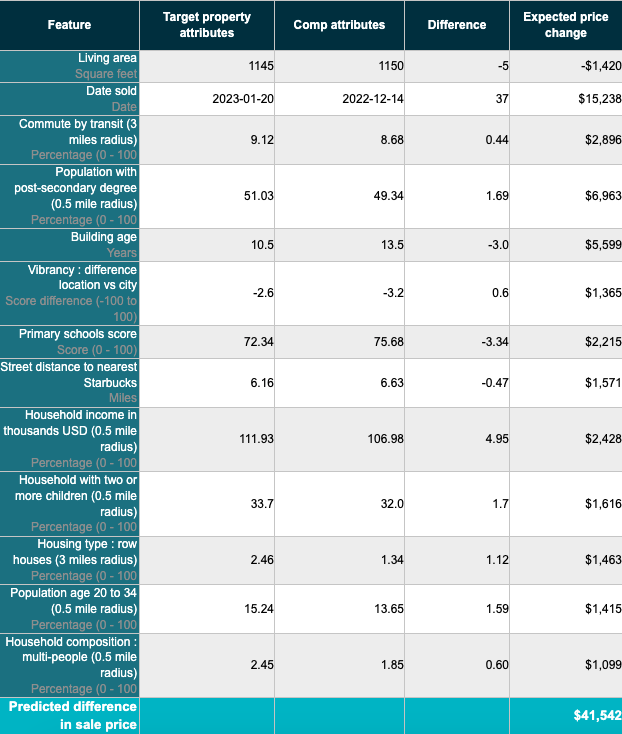Product Spotlight: NeighborhoodWrap
Residential
| 20 Oct 2025

Commercial
Portfolio Analysis
A single-family rental (SFR) investor is looking to understand how location can impact the sales prices of assets within its portfolio.
Through a portfolio analysis, the Client gained more insights into which factors affect sales prices, allowing them to better assess investment opportunities.
Using a predictive model alongside location characteristics and property features, the Client is able to set sales prices for their future SFR purchases.
Note: In this case study, the client shall remain unidentified to protect their privacy and anonymize their data.
While 52% of the value of a property ties back to traditional real estate factors, such as construction year and living area, the remaining 48% is derived from its location. However, assessing location value has traditionally been challenging.
Seeking more accurate and predictive analysis, the real estate industry is increasingly turning to data-driven solutions to uncover a property’s full value and understand the differences between assets.
Client X is a single-family rental (SFR) investor that manages a portfolio of approximately 3,500 unique assets in a dense, major urban market. Although the Client already has access to traditional real estate data, such as the building age and number of bedrooms, they needed more insights to complement their dataset and better predict the home sales prices of their SFR properties.
Acquisition and divestment prices affect the way the Client assesses new opportunities and manages its existing portfolio over time. It was essential for them to have a model that helps them understand how location impacts sales prices so they could better price their properties in the specific market they were interested in.
The real estate company partnered with Local Logic to analyze its portfolio and examine the impact of hundreds of location characteristics on sales prices within a specific market. Local Logic is a location intelligence solution that delivers actionable insights and precise analytics on over 250 million individual addresses in Canada and the United States.
To understand the full value of each property in the portfolio, Local Logic combines its set of proprietary location insights (e.g. nearby amenities, transit usage, and demographics) with property attributes provided by the Client (e.g. living area, year of built) to create a single, unified dataset.
On top of providing a more complete picture, this dataset allows us to select features that improve the predictive model’s performance while excluding those that have little impact.
Local Logic provides the Client with both a model and a report that identifies and explains the key drivers of the value of a property.
By integrating asset characteristics provided by the Client as well as location insights provided by Local Logic, the model allows investors to make better, more informed, and more contextual decisions. The goal is to be able to judge whether or not a property makes a good investment.
Through Local Logic’s hyperlocal insights and portfolio analysis, this partnership led to:
While the square footage of an asset’s living area is by far the most important determinant of its sales price, a number of location features also rank highly. From the hundreds of location features that were considered, Local Logic retained 17 based on their importance in helping improve model accuracy. Of these, some stood out as more important than others.
Within the specific market that the Client is looking at, the top five most important location drivers of value for single-family home sales prices are:

Location features impacting SFR sales prices
Assuming all else is held constant, the table above shows by how much the sales price of a home can change per feature unit increase.
⬇️ Download our Portfolio Analysis Sample Report to view the full list of features, including both property and location characteristics.
Furthermore, findings from the model indicate that:
Alongside the report, the sales price exploration tool built by Local Logic gives the Client access to data for any address in the market and findings from the model.
This tool can be used to investigate the factors that influence sales prices and assess the impact of location on driving prices up or down. These insights help understand the value of a prospective property and estimate important metrics, like capitalization rates.
The Client can adjust the characteristics of the home to determine how much future assets should be priced according to their own variables.
In the example below, the model is used to compare the factors that drive the sales prices of two very similar prospective homes.
Both properties have the same amount of living space and an identical number of bedrooms and bathrooms. However, Prospective Property A is located in an area with a slightly higher level of education, more transit users, and a better Vibrancy Score compared to Prospective Property B.

Prospective Property A is predicted to have a higher sales price than Prospective Property B, despite having only small, but key, differences in their location features. Specifically, Prospective Property A is expected to sell for $14,072 more than Prospective Property B, solely due to its slightly more favorable location characteristics.
As demonstrated, Local Logic’s granular location features can explain why two seemingly identical properties in very similar locations differ in value.
Comps can be useful for triangulating a property’s potential sales price, but they never have the same characteristics as the target property. For example, two properties may be considered generally close to an elementary school, but one could be closer by 100 meters.
Using the model alongside property and location attributes for comps, the Client can estimate the difference in price between the target property and the comps considered.
The most powerful way to use the sales price prediction model is in conjunction with actual comps. Using Local Logic’s model, it is possible to estimate the difference in sales price between a target property and selected comps based on the difference in the values observed across the target property and those comps.
While it is possible to compare as many properties as desired, the example below estimates the sales price of a target property given one comparable property.
Both properties are single-story and have 2 bathrooms, 3 bedrooms, and a similar amount of living space (roughly a 0.4% difference). While the properties are situated only 0.3 miles from each other, subtle but important differences are observable in their location attributes.

Target property vs. comp
Many investors assume they can ‘control for location’ by selecting comps near a prospective property, but this table demonstrates that location attributes vary, even in close proximity. So, despite these two properties being close to each other, there are small differences in their location that add up to a difference in price.
Among the most important drivers of price differences, there are:
According to the sales price exploration tool, the target property should be priced at $41,542 more than the comparable property. The tool also gives insight into which attributes are most responsible for the estimated price difference between the two properties.
A collaboration with Local Logic allowed Client X to:
💡 Curious about location insights?
Get a demo to learn how to grow your business with location data.